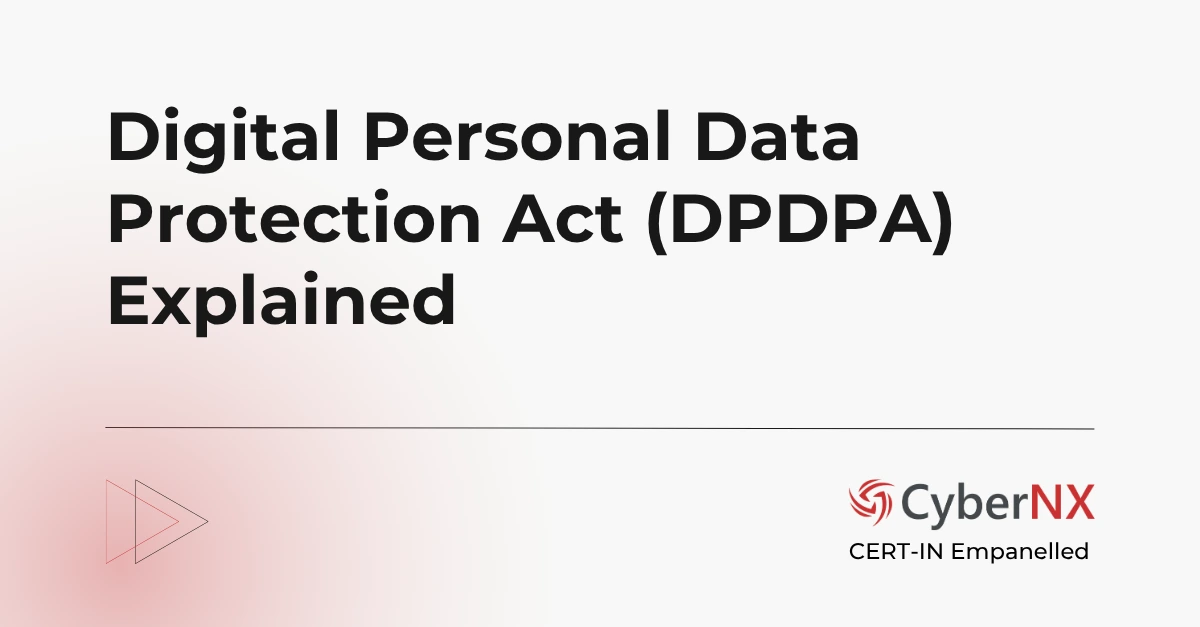Business organizations today increasingly rely on data to drive digital transformation. In this context, India’s Digital Personal Data Protection Act (DPDPA) 2023 marks a pivotal shift in the country’s approach to personal data governance. It establishes a clear framework to ensure that personal data is processed responsibly, securely and transparently. With its emphasis on consent, accountability, and individual rights, DPDPA is at par with global data protection standards.
This Digital Personal Data Protection Act Guidelines will serve as a practical resource for businesses seeking clarity. It breaks down complex legal provisions into actionable steps, helping organizations understand their obligations, build compliant data processing practices and prepare for future enforcement. In short, this guideline explains the Act in simple terms and outlines actionable steps for companies.
In addition, early compliance not only minimizes regulatory risk but also strengthens trust with customers, partners, and regulators.
Understanding the DPDP Act
The Act’s core objective is to protect the personal data of individuals (“Data Principals”) while permitting businesses (“Data Fiduciaries”) to process data for lawful purposes. This includes data collected in India and data processed outside India if it involves offering goods or services to Indian residents.
If you want to know more about the DPDPA Act, check out our Guide to the Digital Personal Data Protection Act
Key Principles of the Act
The DPDPA is built on foundational principles that govern how personal data should be collected, processed and protected. These principles promote transparency, accountability and respect for individual rights throughout the data lifecycle.
Therefore, before learning about the implementation guidelines for the Digital Personal Data Protection Act, find out the key principles governing it:
- Consent-Based Processing: Data Fiduciaries must obtain clear and unambiguous consent from Data Principals before processing their data. This consent must be freely given, specific to the purpose, informed, unconditional and demonstrably affirmative.
- Purpose Limitation: Data can only be processed for the specific purpose for which consent was obtained.
- Data Minimisation: Data Fiduciaries should only collect and process the minimum amount of data necessary for the stated purpose.
- Data Security: Data Fiduciaries are obligated to implement appropriate technical and organisational measures to safeguard personal data and prevent breaches.
- Accountability: Data Fiduciaries are responsible for complying with the Act, even if data processing is delegated to a Data Processor.
What About the DPDPA Timelines?
Although the Act’s official enforcement date is pending, businesses should start preparing now with the help of this DPDPA guidelines. Why this is important? Because early adoption showcases a commitment to data protection and mitigates future risks.
Digital Personal Data Protection Act Guidelines: Actionable Steps
To align your business with the DPDPA guidelines, you must take proactive measures to assess, secure and manage personal data. This section outlines clear, practical steps to help organizations operationalise compliance and build a strong and resilient data protection framework.
1. Data Inventory and Mapping
Establishing a clear understanding of your data landscape is the foundation of DPDPA compliance.
- Identify all personal data collected, processed and stored.
- Document the purpose of processing, legal basis (consent or legitimate use), data retention periods and data sharing practices.
2. Consent Management
A robust consent framework ensures individuals’ autonomy and protects your organization from legal risk.
- Review existing consent mechanisms and update them to comply with the Act’s requirements for free, specific, informed, unconditional and unambiguous consent.
- Provide clear and concise privacy notices that explain data processing practices in plain language.
- Implement mechanisms for individuals to withdraw consent easily.
- Offer individuals the option to access information in English or any language specified in the Eighth Schedule of the Constitution.
3. Data Security
Strong security controls reduce the risk of data breaches and demonstrate accountability to regulators and users.
- Conduct thorough risk assessments to identify vulnerabilities.
- Implement appropriate technical and organisational measures to secure personal data. This includes access controls, encryption, intrusion detection systems and regular security audits.
- Establish a comprehensive data breach response plan to swiftly contain, investigate and remediate breaches.
- Ensure prompt notification of data breaches to the Board and affected Data Principals.
4. Data Protection Officer (DPO)
Appointing a qualified DPO ensures oversight, expert guidance, and regulatory alignment for high-risk data processing.
- Significant Data Fiduciaries (those processing large volumes of sensitive data) must appoint a Data Protection Officer (DPO) based in India.
- The DPO will be responsible for overseeing data protection compliance, advising the company and acting as a point of contact for the Board and Data Principals.
5. Data Subject Rights
Establish procedures to facilitate Data Principal rights, including:
- Right to Access: Providing individuals with a summary of their personal data being processed and details about processing activities.
- Right to Correction: Correcting inaccurate or incomplete data.
- Right to Erasure: Deleting personal data when consent is withdrawn or the purpose of processing is no longer served, unless retention is mandated by law.
- Right to Grievance Redressal: Establishing a mechanism for individuals to raise concerns and seek remedies.
6. Vendor Management
Ensuring third-party processors meet DPDPA standards is critical for maintaining end-to-end data protection.
- Assess the data protection practices of Data Processors (third parties processing data on your behalf).
- Ensure contracts with Data Processors include appropriate data protection clauses that align with the Act’s requirements.
7. Awareness and Training
Building internal awareness ensures that employees understand their data protection responsibilities and act in compliance.
- Conduct regular training programmes for employees on data protection principles and the Act’s requirements.
How CyberNX Can Help?
CyberNX can provide expert guidance and support throughout your DPDPA compliance journey. Here’s how:
- Data Protection Gap Analysis: We evaluate your existing practices against the Act’s requirements and identify areas for improvement.
- Compliance Roadmap Development: We help you create a tailored roadmap for achieving compliance with the Act.
- Policy and Procedure Development: We draft and implement compliant privacy policies, procedures, and consent mechanisms.
- Data Security Assessments and Implementation: We assess your security posture and recommend and implement robust security controls.
- Data Breach Response Planning and Training: We help you develop and test a data breach response plan and provide training to your team.
- DPO as a Service: We can act as your outsourced DPO, providing expert guidance and oversight of your data protection programme.
The Digital Personal Data Protection Act (DPDPA) is a landmark legislation that significantly strengthens data protection in India. CyberNX, with expertise in cybersecurity and data privacy, can play a crucial role in implementing the Digital Personal Data Protection Act guidelines and helping organisations maintain compliance with DPDP Act. Connect with us today!
Digital Personal Data Protection Act
What qualifies an organization as a “Significant Data Fiduciary” under the DPDPA?
A Significant Data Fiduciary is an entity identified by the government based on factors like the volume and sensitivity of data processed, risk to the rights of individuals, and impact on national interests. Such organizations must fulfill additional compliance requirements, including appointing a Data Protection Officer (DPO) and conducting regular audits.
Can consent under the DPDPA be collected through bundled or pre-checked forms?
No. The DPDPA mandates that consent must be clear, specific, informed, and demonstrably affirmative. Pre-checked boxes bundled consent forms, or implied consent mechanisms do not meet the Act’s standards and may result in non-compliance penalties.
Does the DPDPA apply to anonymized or pseudonymized data?
The DPDPA does not apply to fully anonymized data – i.e., data that cannot be re-identified by any means. However, pseudonymized data (where identifiers can be restored) still qualifies as personal data under the Act and must be protected accordingly.
How should startups or small businesses begin their DPDPA compliance journey?
Startups should start by identifying all personal data they collect and understanding how it’s used. A phased approach – starting with consent management, data mapping, and basic security controls – is often the most feasible. Engaging a DPO-as-a-Service provider can also help ensure affordable compliance oversight without full-time resources.



